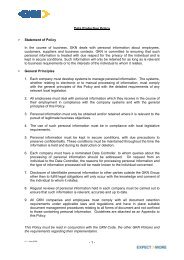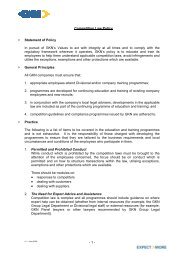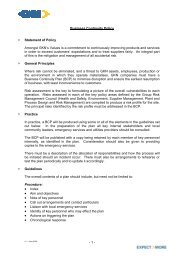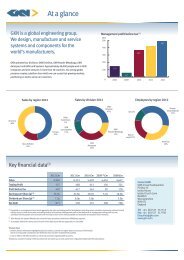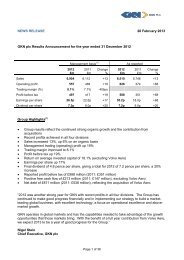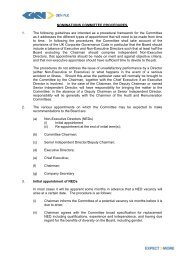Annual Report 2008 in PDF - GKN
Annual Report 2008 in PDF - GKN
Annual Report 2008 in PDF - GKN
Create successful ePaper yourself
Turn your PDF publications into a flip-book with our unique Google optimized e-Paper software.
104<br />
Notes to the F<strong>in</strong>ancial Statements<br />
cont<strong>in</strong>ued<br />
19 F<strong>in</strong>ancial risk management<br />
The Group’s activities give rise to a number of f<strong>in</strong>ancial risks: market risk, credit risk and liquidity risk. Market risk <strong>in</strong>cludes foreign exchange<br />
risk, cash flow and fair value <strong>in</strong>terest rate risk and commodity price risk. The Group has <strong>in</strong> place risk management policies that seek to limit the<br />
adverse effects on the f<strong>in</strong>ancial performance. Derivative f<strong>in</strong>ancial <strong>in</strong>struments, ma<strong>in</strong>ly forward foreign exchange contracts, are used to hedge<br />
risk exposures that arise <strong>in</strong> the ord<strong>in</strong>ary course of bus<strong>in</strong>ess.<br />
Risk management policies have been set by the Board and are implemented by the central Treasury Department that receives regular reports<br />
from all the operat<strong>in</strong>g companies to enable prompt identification of f<strong>in</strong>ancial risks so that appropriate actions may be taken. The Treasury<br />
Department has a policy and procedures manual that sets out specific guidel<strong>in</strong>es to manage foreign exchange risks, <strong>in</strong>terest rate risk, f<strong>in</strong>ancial<br />
credit risk and liquidity risk and the use of f<strong>in</strong>ancial <strong>in</strong>struments to manage these. These disclosures should be read <strong>in</strong> conjunction with the<br />
f<strong>in</strong>anc<strong>in</strong>g and risk commentary <strong>in</strong> the bus<strong>in</strong>ess review on pages 36 to 39.<br />
(a) Foreign exchange risk<br />
The Group has transactional currency exposures aris<strong>in</strong>g from sales or purchases by operat<strong>in</strong>g subsidiaries <strong>in</strong> currencies other than the<br />
subsidiaries’ functional currency. These exposures are forecast on a monthly basis by operat<strong>in</strong>g companies and are reported to the central<br />
Treasury Department. Under the Group’s foreign exchange policy, such exposures are hedged on a reduc<strong>in</strong>g percentage basis over a number of<br />
forecast time horizons.<br />
The Group has a significant <strong>in</strong>vestment <strong>in</strong> overseas operations. As a result, the sterl<strong>in</strong>g value of the Group’s balance sheet can be affected by<br />
movements <strong>in</strong> exchange rates. Until December <strong>2008</strong>, the Group’s policy was to mitigate the effect of these translational currency exposures for<br />
major currencies (US dollar, euro and yen) by hedg<strong>in</strong>g 70% to 90% of the net <strong>in</strong>vestment <strong>in</strong> overseas operations us<strong>in</strong>g forward foreign currency<br />
contracts or foreign currency borrow<strong>in</strong>gs. Such hedg<strong>in</strong>g <strong>in</strong>struments were <strong>in</strong> place until maturity <strong>in</strong> December <strong>2008</strong>. The net <strong>in</strong>vestment<br />
hedg<strong>in</strong>g policy was suspended <strong>in</strong> December <strong>2008</strong> due to concerns about settlement values at a time of exchange rate volatility.<br />
The ma<strong>in</strong> impact of foreign exchange risk on the Group’s results arises from the translation <strong>in</strong>to sterl<strong>in</strong>g of the results of operations outside<br />
of the UK. The Group’s largest exposures are the euro and the US dollar where a 1% movement <strong>in</strong> the average rate impacts trad<strong>in</strong>g profit of<br />
subsidiaries and jo<strong>in</strong>t ventures by £1.2 million and £0.8 million respectively.<br />
Regard<strong>in</strong>g f<strong>in</strong>ancial <strong>in</strong>struments, a 1% strengthen<strong>in</strong>g of sterl<strong>in</strong>g aga<strong>in</strong>st the currency rates <strong>in</strong>dicated below would have the follow<strong>in</strong>g impact on<br />
operat<strong>in</strong>g profit:<br />
<strong>GKN</strong> plc <strong>Annual</strong> <strong>Report</strong> <strong>2008</strong><br />
Trad<strong>in</strong>g profit<br />
Payables and<br />
Derivative<br />
f<strong>in</strong>ancial Intra-group<br />
receivables <strong>in</strong>struments fund<strong>in</strong>g<br />
£m £m £m<br />
Euro 0.2 (0.4) (1.3)<br />
US dollar (0.3) 8.3 (1.0)<br />
The derivative sensitivity analysis has been prepared by reperform<strong>in</strong>g the calculations used to determ<strong>in</strong>e the balance sheet values adjusted<br />
for the changes <strong>in</strong> the <strong>in</strong>dividual currency rates <strong>in</strong>dicated with all other cross currency rates rema<strong>in</strong><strong>in</strong>g constant. The sensitivity is a fair<br />
value change relat<strong>in</strong>g to derivatives for which the underly<strong>in</strong>g transaction has not occured at 31 December. The Group <strong>in</strong>tends to hold all such<br />
derivatives to maturity. The analysis of other items has been prepared based on an analysis of a currency balance sheet.<br />
Analysis of net borrow<strong>in</strong>gs by currency:<br />
<strong>2008</strong> 2007<br />
Cash and Cash and<br />
cash cash<br />
Borrow<strong>in</strong>gs equivalents Total Borrow<strong>in</strong>gs equivalents Total<br />
£m £m £m £m £m £m<br />
Sterl<strong>in</strong>g (726) 24 (702) (702) 152 (550)<br />
US dollar (27) 15 (12) (36) 10 (26)<br />
Euro (10) 35 25 (12) 41 29<br />
Others (59) 40 (19) (38) 79 41<br />
(822) 114 (708) (788) 282 (506)



